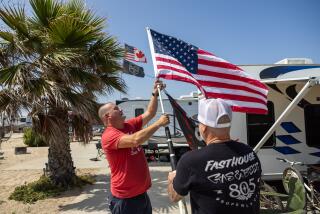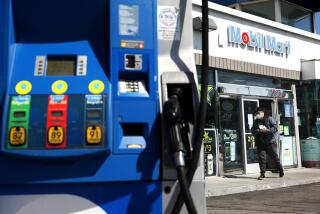Myths on raising gas mileage
- Share via
Not everything you’ve heard about increasing gas mileage is true.
There are plenty of legitimate ways to stretch your mileage: slow down, keep tires at proper inflation, avoid quick acceleration, don’t pile luggage on a roof rack, use a properly fitted gas cap.
But at this time of skyrocketing gasoline prices, several myths are circulating. The claims were tested by car experts at the Automobile Club of Southern California and Consumer Reports magazine.
Fill up in the morning
The theory is that gas expands in warm weather, so if you visit the filling station early in the day when the temperature is cooler, you get denser fuel that contains more energy per gallon. In other words, fill up when it’s cool to get more bang for your gasoline buck.
There’s nothing wrong with the theory, except that it doesn’t apply in this situation. That’s because gas station storage tanks are so well-insulated these days that outside temperature has little effect.
“The key thing is the temperature of the gas when the tanker truck leaves it at the gas station,” said Steve Mazor, manager of the auto club’s research center. “If it’s hot, it will stay hot, and vice versa.”
No matter what time of day you fill up.
Change your air filter
The test team at Consumer Reports was sure that a car would get better mileage with a clean rather than a dirty air filter.
“It stands to reason that if the air is allowed to flow freely, it would result in better fuel economy,” spokesman Douglas Love said.
To do the test, the team used duct tape to partially cover the air intake, simulating a dirty filter. And the result?
“We were surprised to find out it didn’t much matter,” Love said. “The mileage was about the same.”
So, testers added a bit more tape and then some more. Short of blocking off all the air, they got the same results.
“We found that the onboard computers that adjust the fuel mixtures on recent cars did a surprisingly effective job,” he said.
The auto club ran a test with clean and dirty fuel filters on several different cars. Results were similar.
“There was even one test where the mileage got a little bit better -- maybe 1% or 2% -- with the dirty filter,” Mazor said.
But before you count the money you can save in air filters, there is a price to pay.
“The trade-off was that carbon monoxide emissions went up,” he said.
Turn off your car’s a/c
Anyone who had a car with air conditioning before 1980 or so can tell you about the load the cooling device would place on the engine, especially in a small car.
You’d turn on the a/c, and suddenly you’d have to step on the gas or even shift gears to get back up to speed.
To make matters worse, it was thought that driving with the windows down would generate drag that would also cut into mileage.
But not so much anymore, especially at highway speeds.
“Our tests show that neither makes enough of a difference to worry about,” Consumer Reports wrote in its June issue. “Using air conditioning while driving at 65 mph reduced the Camry’s gas mileage by about 1 mpg. The effect of opening the windows at 65 mph was not even measurable.”
The effect of turning off the air is probably more profound in stop-and-go traffic situations, but not much.
“I would guess it could be a 5% mileage saving,” Mazor said.
Buy additives, devices
Mazor, who has been with the auto club for 23 years, has been involved in tests of about 50 products that were supposed to boost mileage.
“There were additives for the fuel and the oil, magnetic devices that would wrap around the fuel line, things that would fit either in or on the air intake, devices that would add an electrostatic charge,” he said. “We tried them all.”
Consumer Reports also tried devices ranging from $50 to $250.
The verdict was unanimous. The products didn’t work, or at least not to the degree that they were worth buying.
Of all the wacky ways people have tried to get better mileage, the strangest one Mazor had seen was a series of three small decals.
“They were to go onto the gas tank, and I think they were supposed to have holographic circuitry,” he said. “The inventor claimed to have captured frequency energy from the fifth dimension that could double the miles per gallon.”
Perhaps the inventor was inhaling too many gas fumes.
“He also made a sticker that was supposed to be placed within 2 inches of the human body to lose weight,” Mazor said. “I put it in my wallet and carried it around for months.
“That didn’t work either.”
--







